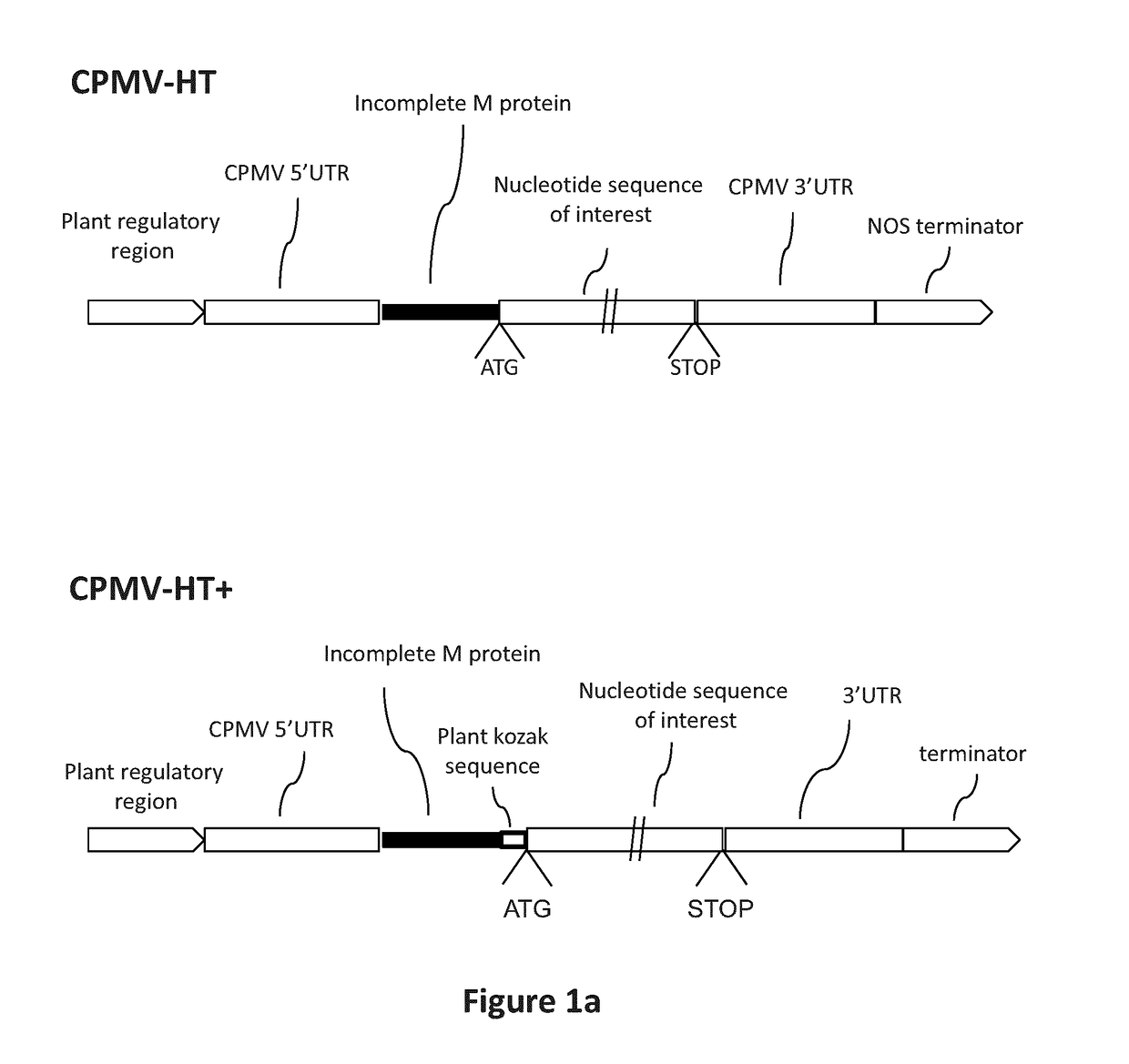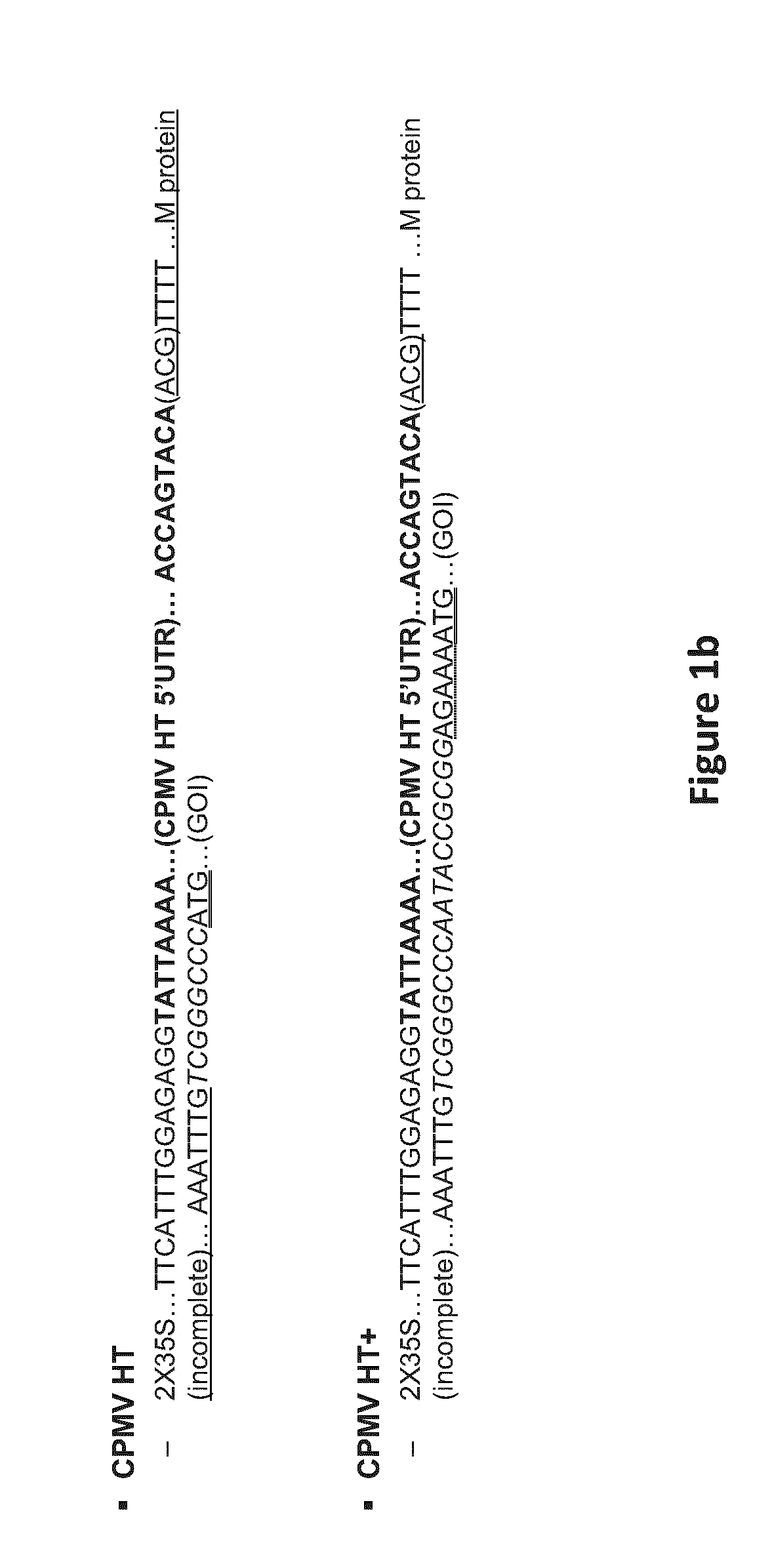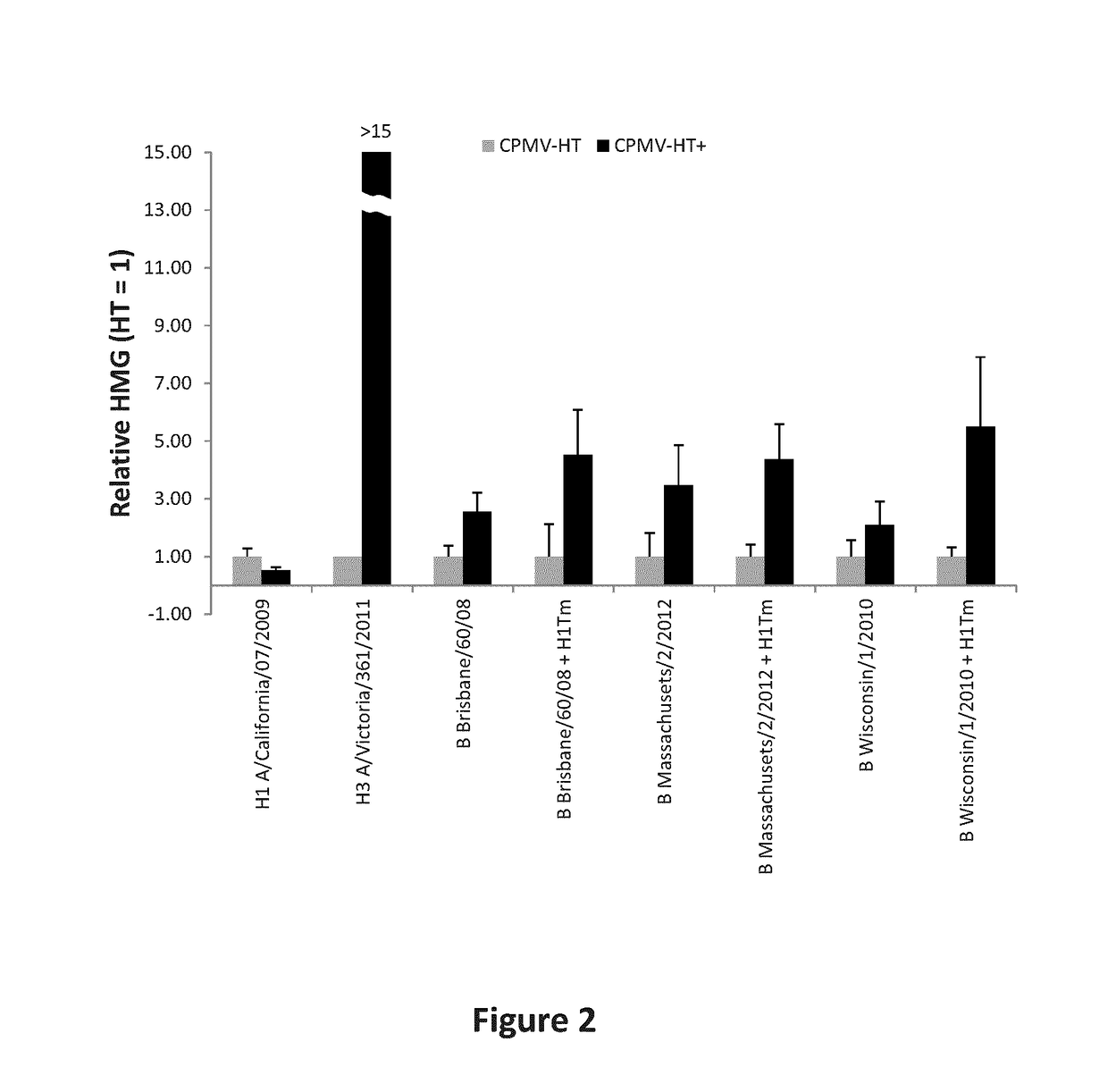Modified CPMV Enhancer Elements
a technology of enhancer elements and cpmv, which is applied in the field of plant protein expression, can solve the problems of limiting the size of inserted sequences, time-consuming and labor-intensive processes, etc., and achieves the effect of easy infecting plants and good yield of useful protein materials
- Summary
- Abstract
- Description
- Claims
- Application Information
AI Technical Summary
Benefits of technology
Problems solved by technology
Method used
Image
Examples
example 1
V-HT / PDISP / H3 Victoria / NOS (Construct Number 1391)
[0152]A sequence encoding H3 from Influenza A / Victoria / 361 / 2011 in which the native signal peptide has been replaced by that of alfalfa protein disulfide isomerase (PDISP / H3 Victoria) was cloned into 2X35S-CPMV-HT-NOS expression using the following PCR-based method. A fragment containing the PDISP / H3 Victoria coding sequence was amplified using primers IF-PDI.S1+3c (FIG. 5A, SEQ ID NO: 18) and IF-H3V36111.s1-4r (FIG. 5B, SEQ ID NO: 19), using PDISP / H3 Victoria sequence (FIG. 5C, SEQ ID NO: 20) as template. The PCR product was cloned in 2X35S / CPMV-HT / NOS expression system using In-Fusion cloning system (Clontech, Mountain View, Calif.). Construct number 1191 (FIGS. 5D and 5E, SEQ ID NO: 21) was digested with SacII and StuI restriction enzyme and the linearized plasmid was used for the In-Fusion assembly reaction. Construct number 1191 is an acceptor plasmid intended for “In Fusion” cloning of genes of interest in a CPMV-HT-based expre...
example 2
V-HT+ / PDISP / H3 Victoria / NOS (Construct Number 1819)
[0153]A sequence encoding H3 from Influenza A / Victoria / 361 / 2011 in which the native signal peptide has been replaced by that of alfalfa protein disulfide isomerase (PDISP / H3 Victoria) was cloned into 2X35S-CPMV-HT+ / NOS expression using the following PCR-based method. A fragment containing the PDISP / H3 Victoria coding sequence was amplified using primers IF(SacII)-Kozac_PDI.c (FIG. 6A, SEQ ID NO: 24) and IF-H3V36111.s1-4r (FIG. 5B, SEQ ID NO: 19), using PDISP / H3 Victoria sequence (FIG. 8C, SEQ ID NO: 20) as template. The PCR product was cloned in 2X35S / CPMV-HT+ / NOS expression system using In-Fusion cloning system (Clontech, Mountain View, Calif.). Construct number 2181 (FIG. 6B) was digested with Sacll and StuI restriction enzyme and the linearized plasmid was used for the In-Fusion assembly reaction. Construct number 2181 is an acceptor plasmid intended for “In Fusion” cloning of genes of interest in a CPMV-HT+ based expression cass...
example 3
Variation of Sequence Between SacII Restriction Site and ATG of PDISP / H3 Victoria in 2X35S / CPMV HT+ / NOS Expression System (Constructs Number 1952 to 1959)
[0154]Eight constructs comprising sequence variations between SacII restriction site and the ATG of PDISP / H3 Victoria in 2X35S / CPMV HT+ / NOS expression system were created using the same PCR-based method as in construct no 1819 (see Example 2) with a modified forward primer and keeping all other steps the same. Variant HT1* to HT8* were amplified using the primers listed in Figures FIG. 7A-7H:
[0155]IF-HT1*(-Mprot)-PDI.c (FIG. 7A, SEQ ID NO: 27),
[0156]IF-HT2*(-Mprot)-PDI.c (FIG. 7B, SEQ ID NO: 28),
[0157]IF-HT3*(-Mprot)-PDI.c (FIG. 7C, SEQ ID NO: 29)
[0158]IF-HT4*(-Mprot)-PDI.c (FIG. 7D, SEQ ID NO: 30)
[0159]IF-HT5*(-Mprot)-PDI.c (FIG. 7E, SEQ ID NO: 31)
[0160]IF-HT6*(-Mprot)-PDI.c (FIG. 7F, SEQ ID NO: 32)
[0161]IF-HT7*(-Mprot)-PDI.c (FIG. 7G, SEQ ID NO: 33) and
[0162]IF-HT8*(-Mprot)-PDI.c (FIG. 7H, SEQ ID NO: 34),
to create construct no 19...
PUM
| Property | Measurement | Unit |
|---|---|---|
| size | aaaaa | aaaaa |
| size | aaaaa | aaaaa |
| size | aaaaa | aaaaa |
Abstract
Description
Claims
Application Information
 Login to View More
Login to View More - R&D
- Intellectual Property
- Life Sciences
- Materials
- Tech Scout
- Unparalleled Data Quality
- Higher Quality Content
- 60% Fewer Hallucinations
Browse by: Latest US Patents, China's latest patents, Technical Efficacy Thesaurus, Application Domain, Technology Topic, Popular Technical Reports.
© 2025 PatSnap. All rights reserved.Legal|Privacy policy|Modern Slavery Act Transparency Statement|Sitemap|About US| Contact US: help@patsnap.com



